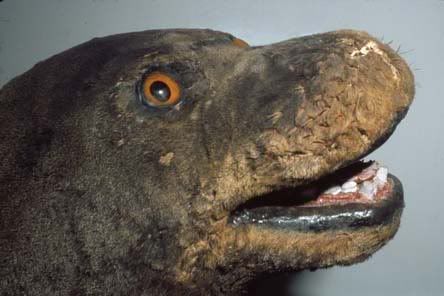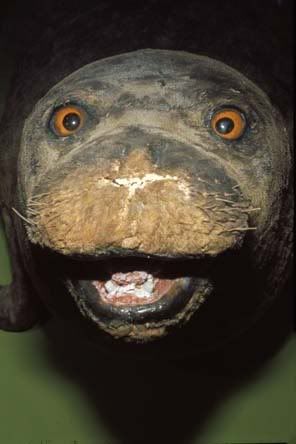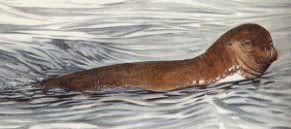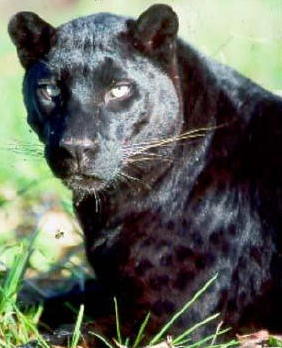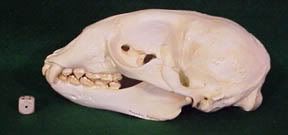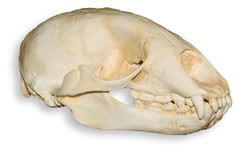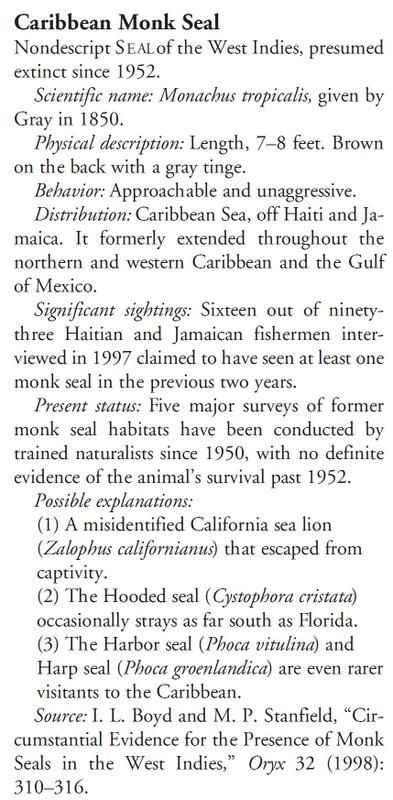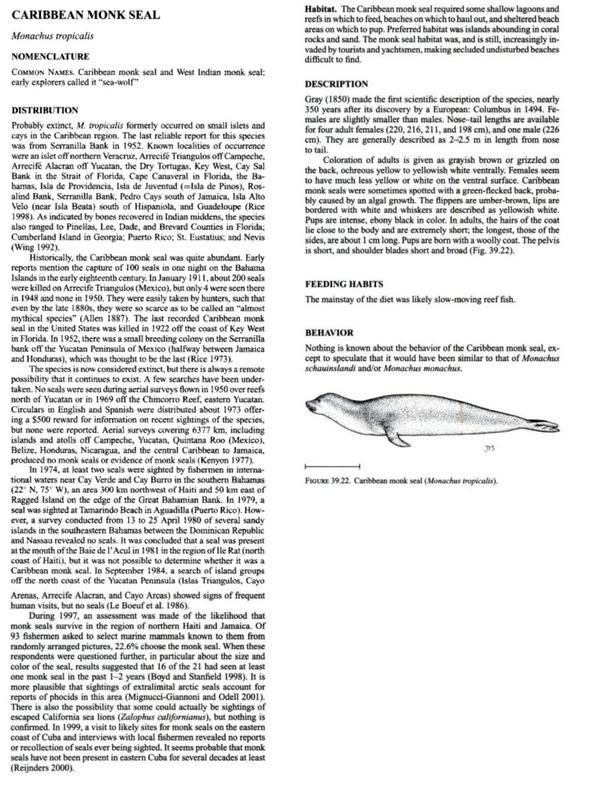Endangered Species Act 5-Year Review
Caribbean Monk Seal
(Monachus tropicalis)
National Oceanic and Atmospheric Administration
National Marine Fisheries Service
March 2008
5-YEAR REVIEW
Caribbean monk seal (Monachus tropicalis)
TABLE OF CONTENTS
1.0 GENERAL INFORMATION...................................................................................... 3
2.0 REVIEW ANALYSIS................................................................................................... 5
3.0 RESULTS .................................................................................................................... 15
4.0 RECOMMENDATIONS FOR FUTURE ACTIONS.............................................. 15
5.0 REFERENCES............................................................................................................ 16
2
5-YEAR REVIEW
Caribbean monk seal (Monachus tropicalis)
1.0 GENERAL INFORMATION
1.1 Reviewers
Lead Regional Office
Kyle Baker, National Oceanic and Atmospheric Administration, National Marine Fisheries
Service, Southeast Regional Office, St. Petersburg, Florida (727) 824-5312
Cooperating Science Centers:
Jason Baker, National Oceanic and Atmospheric Administration, National Marine Fisheries
Service, Pacific Islands Fisheries Science Center, Honolulu, Hawaii
Larry Hansen, National Oceanic and Atmospheric Administration, National Marine Fisheries
Service, Southeast Fisheries Science Center, Beaufort Laboratory, Beaufort, North Carolina
Gordon T. Waring, Northeast Fisheries Science Center, Woods Hole Laboratory, Woods Hole,
Massachusetts
Document Peer Reviewed By
Dr. Ian Boyd, University of St. Andrews, Sea Mammal Research Unit, St. Andrews, Scotland
William Johnson, Editor, The Monachus Guardian, Bern, Switzerland.
David Laist, Marine Mammal Commission, Bethesda, Maryland, USA
1.2 Method used to complete the review: This review was prepared pursuant to section
4(c)(2) of the Endangered Species Act (ESA) and in accordance with sections 4(a) and (b) of the
ESA following guidance provided in the joint NMFS and U.S. Fish and Wildlife 5-Year Review
Guidance and template (http://www.nmfs.noaa.gov/pr/pdfs/laws/guidance_5_year_review.pdf).
The National Marine Fisheries Service (NMFS) of the National Oceanic and Atmospheric
Administration (NOAA) initiated a 5-year review of the Caribbean monk seal (Monachus
tropicalis) in November 2006. NMFS convened a four-member status review team to compile
and review information to assess the status of the Caribbean monk seal. NMFS solicited
information from the public through Federal Register notice (71 FR 39327; November 29, 2006),
as well as through personal and written communications with individuals. NMFS considered the
solicited information from the public, a literature review, and current information regarding
pinniped sightings in the southeast U.S. and Caribbean regions to assess the possibility that this
species continues to exist in the wild. To complete the 5-year review, we evaluated all
information that has become available on the species since 1984, the date of its last biological
status review.
3
1.3 Background
1.3.1 FR Notice citation announcing initiation of this review
NMFS announced initiation of the 5-year review for Caribbean monk seals (M. tropicalis) and
asked the public to submit information regarding the species' status on November 29, 2006 (71
FR 39327). Comments were received and incorporated as appropriate into the 5-year review.
1.3.2 Listing history
Original Listing (under Endangered Species Preservation Act of 1966)
FR notice: 32 FR 4001
Date listed: March 11, 1967
Entity listed: entire species
Classification: endangered
Revised Listing
FR notice: 44 FR 21288
Date listed: April 10, 1979
Entity listed: entire species
Classification: endangered
1.3.3 Associated rulemaking
None.
1.3.4 Review History
Monk Seal 5-Year Review: November 9, 1984
A Caribbean monk seal 5-year review published on November 9, 1984, determined that the best
available information indicated the Caribbean monk seal is extinct. No sightings or evidence of
Caribbean monk seals have been documented since the last confirmed sighting at Seranilla Bank,
between Jamaica and the Yucatán Peninsula, in 1952. Therefore, the 5-year review
recommended that the species be removed from the list of endangered and threatened species
under the ESA (49 FR 44774). Following the 1984 status review, the U.S. Marine Mammal
Commission contracted a study to interview local fishermen, residents, and sailors along the
north coast of Haiti (Woods and Hermanson 1987). Although there were two reported seal
sightings obtained during the survey, there was no tangible evidence to confirm whether those
sightings involved Caribbean monk seals or some other species. A subsequent survey of
fishermen in waters of Haiti and Jamaica also reported oral accounts of seal sightings, but again,
there was no corroborating proof that the sightings involved seals, much less Caribbean monk
seals (Boyd and Stanfield 1998). Based on the results of these surveys, NMFS decided not to
delist the species, due the possible existence of a remnant population in the wild.
1.3.5 Species’ Recovery Priority Number at Start of 5-year Review
Because this species is likely extirpated throughout its range, the NMFS October 1, 2004-
September 30, 2006 Biennial Report to Congress on the Recovery Program for Threatened and
Endangered Species assigned the recovery priority number for the Caribbean monk seal as 12.
This represents a low magnitude of threat as a rare population, a low recovery potential, and the
absence of conflict with economic activity.
4
1.3.6 Recovery Plan or Outline
No recovery plan has been prepared for the Caribbean monk seal. Upon the species’ revised
listing under the ESA in 1979, there was no known population existing in the wild. No
information was available upon which a recovery plan could be based.
2.0 REVIEW ANALYSIS
2.1 Application of the 1996 Distinct Population Segment (DPS) policy
The Caribbean monk seal is a vertebrate and subject to the DPS Policy (61 FR 4722). The
species has not been sighted since 1952. There is no information to indicate there is a remaining
population of this species, much less more than one. Identification of DPS’ is not appropriate for
the Caribbean monk seal.
2.2 Recovery Criteria
Recovery plans contain downlisting and delisting criteria with regard to a species’ status and
threats. A recovery plan has not been prepared for the Caribbean monk seal because no
populations of this species were known to exist at the time of listing.
2.3 Updated Information and Current Species Status
No confirmed sightings of Caribbean monk seals have been reported since the last status review
conducted in 1984. Following the 1984 review, the U.S. Marine Mammal Commission
contracted a study to interview fishermen, residents, and sailors along the north coast of Haiti
(Woods and Hermanson 1987). Although potential accounts of seal sightings were obtained
during the survey, no confirmations were obtained. However, based upon a credible account of a
sighting, some isolated animals were believed to potentially remain in some remote regions. A
subsequent survey of fisherman working in waters of the Caribbean monk seal’s former range
provided circumstantial evidence that the species may still exist in the wild (Boyd and Stanfield
1998). Since this time there has been no new information regarding this species. A review of
sightings and stranding data provided evidence of several positively identified arctic phocids in
tropical and sub-tropical waters of the Western North Atlantic from 1917 through 1996
(Mignucci-Giannoni and Odell 2001). Due to confirmed sightings of extralimital arctic species
in the Caribbean region, mostly hooded seals (Cystophora cristata), and lack of any Caribbean
monk seal sightings since 1952, the authors concluded that unidentified sightings in the period
reviewed were not Caribbean monk seals (Mignucci-Giannoni and Odell 2001). Between 1996
and 2007, 22 additional sightings of hooded seals have been confirmed in southeast U.S. waters,
of which 7 occurred in the Caribbean (Southeast U.S. Marine Mammal Stranding Database
2007).
2.3.1 Taxonomic Classification and Phylogeny:
The type specimen for the Caribbean monk seal, also known as the Caribbean seal, the West
Indian seal, and the West Indian monk seal, was described from the scientific literature in 1849
from a specimen taken in Jamaica (Gray 1849). Early references to this species referred to these
5
animals as sea wolves, hair seals, or simply seals. In Spanish, the Caribbean monk seal is known
by many names, including: cabezas de friales, foca caribeña, foca del Caribe, foca monje
caribeña, foca monje de las Antilles, foca monje del Caribe, fraile marino, lobo del mar, lobo
marino, and pez boto (Mignucci-Giannoni 1989). Although the species has several common
names, it is taxonomically described below.
Kingdom: Animalia
Phylum: Chordata
Class: Mammalia
Subclass: Eutheria
Order: Carnivora
Suborder: Pinnipedia
Family: Phocidae
Subfamily Monachinae
Genus: Monachus
Species: tropicalis
A thorough description of the Caribbean monk seal was recently completed by Adam (2004).
The genus Monachus includes 3 allopatric species: M. tropicalis (Caribbean monk seals), M.
schauinslandi (Hawaiian monk seals), and M. monachus (Mediterranean monk seals). Caribbean
monk seals are more closely related to Mediterranean monk seals than to Hawaiian monk seals
(Wyss 1988). However, the phylogenetic relationship among monk seals remains in dispute
(Lavigne 1998). No genetic studies of Caribbean monk seals have been conducted.
2.3.2 Biology
The Caribbean monk seal has a typical seal-like appearance, with a well-developed blubber
layer, flipper-like limbs, a short tail, and a smooth body contour. The head is large and
prominent, eyes are large and light reddish-brown in color (Ward 1887), and external pinnae are
absent. Pups are born black in color and remain that way for about one year (Allen 1887b).
Adult pelage is variably dark dorsally (brown to black) and graded into a lighter yellowish-white
countershade ventrally. Ventral fur ranges from pale yellow to yellowish-gray or yellowishbrown
and is sometimes mottled with darker patches. The front and sides of the muzzle and the
edge of the full and fleshy lips are yellowish-white.
Caribbean monk seals are sexually dimorphic, with females smaller than males (Allen 1887a).
However, the size difference is slight and could not be used to distinguish between the sexes.
The two sexes are also alike in color and form (Allen 1887a). Females have 2 pairs of functional
mammae (Ward 1887). Measurements of adults of both sexes generally range between
2.0-2.5 m (Allen 1887a; Allen 1887c, Ward 1887). The only known photographs of Caribbean
monk seals in the wild appear in Adam and Garcia (2003). The best photograph of this species
was taken at the New York Aquarium in 1910 (Figure 1).
6
Figure 1. A 1910 photograph of Caribbean monk seal at the New York
Aquarium. Specimen captured in Campeche Bank region as described in
Townsend (1909).
Caribbean monk seal vocalizations have been described as roaring, pig-like snorting, moaning,
dog-like barks, growls, and snarls (Gosse 1851, Hill 1843, Nesbitt 1836, Townsend 1909). Pup
vocalizations have been reported as a long, drawn out, guttural ‘‘ah’’ with a series of vocal
hitches during enunciation (Ward 1887). Underwater vocalizations of Caribbean monk seals
have not been described and are unknown. As with both Hawaiian and Mediterranean monk
seals, Caribbean monk seals apparently became sensitized to human presence after exposure to
hunting or other abusive treatment. Thus, although many recent descriptions of monk seals state
that they are highly sensitive to human disturbance, some accounts, including early accounts of
the species (e.g., E.W. Nelson, as cited in Adam and Garcia 2003), describe them as being very
approachable when hauled out on beaches.
Both Mediterranean and Hawaiian monk seals are known to consume a variety of fish,
cephalopods, and crustaceans (Marchessaux 1989, Goodman-Lowe 1998), and it has been
speculated that Caribbean monk seals have a similar diet (Nesbitt 1836, Gosse 1851, Ward
1887). The three species of Monachus have no obvious functional dental or osteological features
to suggest that their feeding habits are significantly different from each other (Adam and Berta
2002).
The incidence of disease in the wild has not been reported, but an occurrence of a condition that
may have been cataracts has been noted (Gaumer 1917, Ward 1887). The nasal mite Halarachne
americana was recovered in great numbers and in all stages of its life cycle from the respiratory
passages of a single captive specimen. The mite, which is only known from Caribbean monk
seals and has not been identified from any other species or habitats since that time, may now be
extinct (Adam 2004). Caribbean monk seals were reported to have heavy parasitic helminth
loads (Adam and Garcia 2003, Ward 1887), but a detailed description and species identification
has not been reported.
2.3.3 Life History
Most observations of life history and behavior of Caribbean monk seals are based on short-term
observations of seals in isolated colonies following heavy exploitation of the species. Due to the
decline of this species after the arrival of the Europeans in the wider Caribbean region and its
rarity by the time the species was first described in the scientific literature, remarkably little is
7
known about its life history. Prior to its depletion, Caribbean monk seals hauled out in groups of
up to 500 individuals (Nesbitt 1836). Accounts of Caribbean monk seals are usually from
isolated islands, keys, and atolls surrounded by shallow, reef-protected waters, and only
occasionally from mainland beaches. Haul out sites are usually sandy beaches that remain
exposed at high tide (Gaumer 1917 and Hill 1843, as summarized in Adam 2004, Kerr 1824,
Ward 1887), but also include near shore rocks and rocky islets (Allen 1880). Haul out sites
typically have sparse or no vegetation and no fresh water (Ward 1887). Adam and Garcia (2003)
and Ward (1887) reported that they usually hauled out on beaches to rest in the early morning,
although sometimes they would haul out and rest overnight.
Very little is known about the effects of over-exploitation on sex ratios of the species. The
male:female ratio of specimens collected during a 1900 expedition in Mexico was 24:76, but by
then the species was already severely depleted. Because such data are limited to a single sample
size from one colony, it is not possible to determine whether that reported sex ratio is
representative, reflective of previous hunting on the sex ratio of the population, or due to some
other unknown factor. The relevance of those data to life history characteristics must therefore
be interpreted with caution.
Observations of feeding seals have not been reported, and there are no reports of prey items from
the few examinations of stomach contents cited in the available literature. Pregnant females are
known only from the Triangle Keys off Mexico, where a newborn suckling pup and 5 females
with fetuses were collected in early December 1886 (Ward 1887) and a single pregnant seal was
killed in late June 1900 (original unpublished field notes of W.E. Nelson as cited in Adam and
Garcia 2003). Adam and Garcia (2003) speculate that Caribbean monk seals have low pupping
synchrony due to the limited seasonal variations in climate and prey abundance. An annual birth
rate of 15% has been calculated, but this is likely an underestimate (Rice 1973). Rice (1973)
concluded that females rarely bore young in successive years and likely produced a pup every
other year; however, research on Hawaiian monk seals (Johanos et al. 1994) and Mediterranean
monk seals (Johnson et al. 2006) has demonstrated that pupping in successive years is common
for those species. Weaning reportedly began 2 weeks after parturition; however, this also may
be an underestimate based on weaning behavior in Hawaiian and Mediterranean monk seals.
Pups apparently developed quickly (Nesbitt 1836). Subadult seals are speculated to have foraged
nocturnally in shallow, nearshore waters to avoid direct competition with adults, which fed at
dawn and dusk (Adam and Garcia 2003). Caribbean monk seals have been estimated to have a
life span of 20-30 years (Adam 2004), but long-term studies of the species in the wild are
lacking. However, this estimate is consistent with that of Hawaiian monk seals, which is thought
to have a life span of approximately 25-30 years.
2.3.4 Distribution
The historic distribution of Caribbean monk seals (Figure 2) has been inferred from historical
sightings, archeological records, fossil evidence, and geographical features bearing names
suggestive of their presence (Adam and Garcia 2003, Adam 2004). The species’ northernmost
record is from a fossil recovered near Charleston, South Carolina. There is evidence that
Caribbean monk seals used mainland beaches of North or Central America as haul-out sites in
great numbers. Most sightings records are from isolated islands, cays, and reefs in the eastern
Gulf of Mexico (Ray 1961, Timm et al. 1997) and western Caribbean Sea. The only evidence
Caribbean monk seals occurred in the Lesser Antilles is from archeological remains in
8
the northern end of the chain (Wing 1992) and a single sighting record (Timm et al. 1997). A
few sighting records, archeological finds, and suggestive place names extend the known range of
Caribbean monk seals to include the northern coast of South America (Timm et al. 1997 and
Debrot 2000).
Figure 2. Distribution of M. tropicalis in the western tropical Atlantic
region based on historical records (closed circles), archaeological and fossil
records (open circles), and localities with names suggestive of occurrence
(triangles) such as Lobos Cay (Cuba), Lobos Cay (Honduras) Cayo Lobo
Marino (Nicaragua), Seal Keys (Bahamas), and Isla de Lobos (Veracruz). For
a description of the source and location data used to define the distribution of
Caribbean monk seals, see Adam and Garcia 2003, Adam 2004, and Timm et
al. 1997. Figure from Adam (2004).
2.3.5 Factors Contributing to the Decline of Caribbean Monk Seals
Although documentation of harvest levels and practices that led to this species’ population
decline is nearly absent, it is evident from early reports that relatively large numbers of seals
persisted in at least some areas as late as the early 1800s and that their precipitous decline in
abundance was due to heavy exploitation by sealers and other people. During the 1800s their
distribution became increasingly fragmented. By the time scientific expeditions were organized
in the late 1800s to document and study the species, their range was already drastically curtailed.
Rice (1973) concluded that the last confirmed sighting of this species was in 1952 at Seranilla
Banks in the western Caribbean.
When determining whether a species is threatened or endangered, we evaluate the five factors
under ESA section 4(a)(1) to specify the reasons for the species’ status:
1. Present or threatened destruction, modification or curtailment of its habitat or range;
2. Overutilization for commercial, recreational, scientific, or educational purposes;
9
3. Disease or predation;
4. Inadequacy of existing regulatory mechanisms; and
5. Other natural or manmade factors affecting its continued existence.
A five-factor analysis of the current threats to the species is superfluous since the species has not
been sighted in over 50 years; however, we can review the factors contributing to this species’
drastic decline. The Caribbean monk seal population was already severely depleted, and likely
extirpated throughout most, if not all, of its range prior to the passage of the ESA and Marine
Mammal Protection Act. The two main factors leading to its listing as endangered are the
modification and curtailment of its habitat and range, and overutilization for commercial and
educational purposes.
2.3.5.1 Present or threatened destruction, modification or curtailment of its
habitat or range
When hauled out on beaches, Caribbean monk seals were reported to have been sensitive to
human disturbance (Allen 1880, Gaumer 1917, Ward 1887). When disturbed, they reportedly
returned to the water where they remained until the people or vessels left the area (Adam and
Garcia 2003, Allen 1880). As human settlements expanded in areas inhabited by this species and
persistent hunting reinforced evasive seal behaviors, avoidance of human presence near
populated shorelines and areas regularly visited by fishermen likely caused seals to abandon
historic haul-out sites. Human encroachment also likely exacerbated stresses on the population
as it declined. Although the species was reported as common in the early to mid-1700s, it was
already considered rare by the mid-1880’s (Allen 1887b, Elliot 1884, Gratacap 1900).
2.3.5.2 Overutilization for Commercial and Educational Purposes
Caribbean monk seals were utilized as a source of meat by early mariners and heavily exploited
as a source of oil following European colonization (Allen 1880). Other human-caused factors
such as entanglement and drowning in fishing nets and slaughter by fishermen viewing the seals
as competitors for fish contributed to their decline (Rice 1973). Caribbean monk seals were also
killed for scientific collection and study, as well as for display in zoological gardens. Adam
(2004) provides an excellent review on the historical exploitation of Caribbean monk seals. He
reports the species was the most readily exploited source of oil in the tropical West Atlantic
Ocean prior to the early 1800s, and that they were hunted to near extinction for their blubber
until the early 1900s.
Blubber was processed and used for lubrication, coating the bottom of boats, and as lamp and
cooking oil. Caribbean monk seal skins were sought to make trunk linings, articles of clothing
(e.g., caps and belts), straps, and bags. In the early 1700s, a girdle fashioned from a Caribbean
monk seal pelt was believed to relieve lower back pain. At least some sailors reportedly prized
monk seal pelts believing that their hairs became erect during rough seas, but remained flat in
calm seas. The Swiss naturalist Konrad Gesner reported accounts from seafarers in the
Caribbean (near the island of Hispaniola) in the 1550s, writing: “Its hair is reputed to be of such
a wondrous nature that the skins or belts are worn by mariners. When thunderstorms, tempests
and other inclement weather is nigh, the hair shall rise and bristle, but when it turns still and
mild, it shall lay down smoothly” (Gesner 1558, as cited in Johnson 2004).
10
Caribbean monk seals were taken for food by sailors stranded on the Arricifés Viboras (Cuba) in
1520, on the Islas de Lobos (Veracruz, Mexico) in 1524, Dry Tortugas (Florida) in 1742, and in
the Triangle Keys (Mexico) in 1846. Guano gatherers visiting the Triangle Keys in 1856
reportedly made a bonfire of 100 barrels of Caribbean monk seal skins and skeletons left behind
by sealers, suggesting that they were heavily exploited for their oil in this region. Fishermen
sometimes hunted the seals for meat until about 1885. In at least one instance, two monk seals
were killed simply ‘‘for fun’’ (Allen 1880). Aside from heavy hunting pressure by humans, the
only known natural predator reported is an unidentified species of shark (Fernández de Oviedo
1944).
As a result of this species’ increasing rarity in the wild, live specimens were eagerly sought by
zoological gardens following the discovery of remnant populations in the late 1800s. In 1897,
two live specimens sold for $50.00 each, and dead or mounted specimens also were sold to
museums. Two scientific expeditions to the Triangle Keys are believed to have contributed to
the extirpation in that region. On four days in December 1886, 49 seals were killed in the
Triangle Keys (Allen 1887, Ward 1887). Live specimens obtained by the New York Aquarium
in 1897 and 1909 also were captured from the Triangle Keys (Townsend 1909).
2.4 Synthesis
Since passage of the ESA, several efforts have been made to investigate unconfirmed reports of
the species in or near the Caribbean Sea, Gulf of Mexico, the Southern Bahamas, and Atlantic
coast of the Greater Antilles. There have been several reports of pinnipeds within the range of
Caribbean monk seals since the last authoritative sighting at the Seranilla Banks in 1952.
Unconfirmed sightings of pinnipeds up to that time resulted in speculation that the Caribbean
monk seal still existed in a few, isolated colonies as late as the mid 1900s. The historical
accounts of the species, unsuccessful expeditions to locate remnant colonies, and confirmed
sightings of pinniped species other than Caribbean monk seal within the species’ historical range
now provide useful perspective on the species’ decline. The following provides a brief historical
account of sightings and survey efforts for the species.
1494: The first sightings records of Caribbean monk seals were made during the second voyage
of Columbus, when 8 individuals were killed for their meat (Kerr 1824).
1700s to 1900s: Caribbean monk seals were exploited intensively for their oil, and to a lesser
extent for food, scientific study, and zoological collection following European colonization.
1886: Caribbean monk seals were reported to occur in the Triangle Keys in the Gulf of
Campeche, where 49 seals were killed during a scientific expedition. (Ward 1887)
1897: The New York Aquarium acquired two specimens captured from the Triangle Keys.
(Townsend 1909)
1906: On February 25, 1906, fishermen killed a Caribbean monk seal five miles off Key West,
Florida. The 1906 account was the first sighting of the species in Florida in approximately 30
years. (Townsend 1906)
11
1909: The New York Aquarium received four live Caribbean monk seals from a dealer in
Progresso, Yucatán. At the time, the last known population of the Caribbean monk seal was
restricted to islands and reefs off the Yucatán, Mexico. (Townsend 1909)
1922: A monk seal was killed by a fisherman near Key West, Florida, on March 15, 1922. This
was the last confirmed sighting of the seal in the United States. Townsend noted a small
breeding colony still remained in the Triángulos reef group (i.e., the Triangle Islands) in the
Campeche Bank islands off Mexico (Townsend 1923)
1932: Following interviews with men having seen seals in the lower Laguna Madre region of
Texas, Gordon Gunter concluded that a few Caribbean monk seals were scattered along the
Texas coast as late as 1932 (Gunter 1947). It was later suggested that the sightings of seals along
the Texas coast were probably feral California sea lions (Zalophus californianus) (Gunter 1968).
1952: C.B. Lewis observed the last authoritative sighting of Caribbean monks at a small seal
colony off Seranilla Banks (Colombia) in 1952, located between Jamaica and the Yucatán
peninsula. (Rice 1973)
1973: The International Union for the Conservation of Nature (IUCN) distributed circulars in
both English and Spanish throughout the Caribbean region in 1973, offering U.S. $500 for
information on recent sightings of the species. No confirmed sightings were made. (Boulva
1979)
1973: The U.S. Fish and Wildlife Service conducted aerial surveys off the Yucatán, south to
Nicaragua, and east to Jamaica of all the areas where Rice suggested that Caribbean monk seals
may still exist. The species was not sighted in the survey area. (Kenyon 1977)
1980: Canada’s Department of Fisheries and Oceans, Arctic Biological Station supported a
search for evidence of Caribbean monk seals in remote islands of the southeastern Bahamas by
vessel and interviews with local fishermen. The vessel survey produced no sightings of seals.
Interviews with fishermen produced a few new accounts of seals in the area during the 1960s and
1970s, but the sightings could not be confirmed as Caribbean monk seals. (Sergeant et al. 1980)
1984: From September 5-15, 1984, a survey was conducted across the Gulf of Mexico to
Campeche, Mexico, aboard the Scripps Institution of Oceanography research vessel, Robert G.
Sproul. The survey crew landed at three island groups off the north coast of the Yucatán
Peninsula considered possible haul-out sites still used by monk seals: Islas Triangulos, Cayo
Arenas and Arrecife Alacran. Another island, Cayo Arcas, was visited by helicopter on
September 7, 1984. The survey yielded no seal sightings or evidence of their continued
existence. (LeBoeuf et al. 1986)
1985: The United States Marine Mammal Commission contracted for a survey of local
fishermen, coastal residents, and sailors in northern Haiti. Two of 77 people interviewed
reported having seen a seal, one of which - a sighting at Île Rat in the Baie de l’Acul in 1981-
was considered a reliable account. In neither case, however, was it possible to confirm the
sighting as a Caribbean monk seal. (Woods and Hermanson 1987)
12
1996: The IUCN Seal Specialist Group listed the Caribbean monk seal as extinct on its Red List
of threatened and endangered species. (Seal Specialist Group 1996)
1997: Based on interviews with 93 fishermen in northern Haiti and Jamaica during 1997, it was
concluded that there was a likelihood that Caribbean monk seals may still survive in this region
of the West Indies. Fishermen were asked to select marine species known to them from
randomly arranged pictures: 22.6% (n=21) selected monk seals of which 78% (n=16) had seen at
least one in the past 1-2 years. (Boyd and Stanfield 1998)
2001: A review of seal sightings and marine mammal stranding data in the Southeast U.S. and
Caribbean region documented evidence of several pinnipeds positively identified as arctic
phocids between 1917 through 1996 that had strayed into the tropical and subtropical waters of
the Western North Atlantic. Due to confirmed sightings of extralimital arctic species, mostly
hooded seals (Cystophora cristata) in the Caribbean region, confirmed sightings and recaptures
of feral California sea lions Zalophus californianus) that had escaped from captivity, and lack of
any confirmed Caribbean monk seal sightings since 1952, the authors concluded that
unidentified sightings since 1952 were likely species other than Caribbean monk seals.
(Mignucci-Giannoni and Odell 2001)
2007: Between 1996 and 2007, 22 additional, confirmed sightings of hooded seals have been
reported from the tropical and subtropical waters of the Western North Atlantic, including seven
from the Caribbean Sea. (Southeast U.S. Marine Mammal Stranding Database data 2007)
Although Caribbean monk seals could be cryptic while at sea and a low number of individuals in
a population may lower the detectability of individuals, hauled out individuals at rest or females
with pups would be conspicuous to an observer. The United Nations Environment Programme,
Caribbean Environment Programme was contacted in December 2007 regarding any new
information on surveys or sightings of Caribbean monk seals that may have been missed by
NMFS review of sightings and stranding data; however, the inquiry resulted in no new
information. With pervasive human presence in the wider Caribbean region and the necessity for
seals to haul-out to rest and pup, it would be expected that any remaining individuals in the wild
would have been sighted and confirmed over the past 50 years. Furthermore, there are few, if
any, remaining areas where Caribbean monk seals were known to occur that have not been
frequented by at least periodic human visits (e.g., fishing activities, recreational activities, and
scientific expeditions). No Caribbean monk seal sightings have been reported from the
numerous scientific surveys conducted in the former range of the species (e.g., avian nesting
colonies, sea turtle nesting beaches, coral reef studies, and other biological and ecological
research). Fishermen, shrimping boats, and abandoned camps have been ubiquitous throughout
the species’ known hauling grounds for decades (Kenyon 1977, LeBoeuf et al. 1986).
Because the range of Caribbean monk seals lies well outside the normal distribution of all other
pinnipeds, sightings of seals are remarkable events in the wider Caribbean region. However,
NMFS’ analysis of stranding data shows that the extralimital occurrence of arctic phocids occurs
with some regularity. Current technology allows for near real-time communication when such
rare or unusual species are sighted. Better methods also exist to confirm species identification
13
when such sightings are made (e.g., photographs and genetic analysis of tissue samples).
Although some seal sightings inevitably are not identifiable to a particular species, all those that
have been confirmed in recent decades within the known range of the Caribbean monk seal have
proven to be other species, namely feral California sea lions (Rice 1973), manatees (Trichechus
manatus), or hooded seals (Mignucci-Giannoni and Odell 2001, NMFS Southeast U.S. Marine
Mammal Stranding Database data 2007). The extralimital occurrence of juvenile hooded seals in
subtropical and tropical waters occurs with enough frequency to account for most recent
pinniped sightings within the former range of the Caribbean monk seal (Mignucci-Giannoni and
Haddow 2002, Mignucci-Giannoni and Odell 2001).
A sufficient amount of time has passed since the last sighting of this species to make an
inference on the status of this species. The Convention on International Trade in Endangered
Species of Wild Fauna and Flora (CITES) and the World Conservation Union have set 50 years
with no sightings as the cut-off for species extinction (World Conservation Union 1982). In
1949, the International Conference on the Protection of Nature (United Nations Scientific
Conference on the Conservation and Utilization of Resources) included the Caribbean monk seal
in a list of 14 mammals whose survival was considered to be a matter of international concern
requiring immediate protection (Westermann 1953). However, the last confirmed sighting of the
species occurred in 1952, limiting any opportunity for conservation efforts of any remaining
animals in the wild. It has been over 50 years since the last confirmed sighting of Caribbean
monk seals in the wild despite multiple survey efforts to locate the species. Solow (1993)
utilized survey data of Caribbean monk seals to demonstrate statistically that the likelihood of
extinction is high based on the lack of sightings of this species. The International Union for the
Conservation of Nature and Natural Resources concluded the Caribbean monk seal was extinct
in 1996 (Seal Specialist Group 1996), but the species remained listed under the ESA in the
United States based on a possibility that some Caribbean monk seals persisted for a few years
after their last confirmed sighting in 1952 at Seranilla Bank.
Although there were no sightings, it is possible that the Caribbean monk seal persisted for a short
period in the years following the last confirmed sighting in 1952 at Seranilla Bank. If so, with an
estimated life span of 20-30 years, some individuals may have possibly persisted into the 1960’s
or 1970’s. If any remnant population did survive, it seems likely they consisted of scattered
individuals, with no remaining colonies large enough to be viable in the wild. Considering the
absence of confirmed seals sightings since 1952, the fact that all confirmed seal sightings have
been of other species, and the ubiquitous presence of humans throughout the species’ range, the
Caribbean monk seal appears to have been extirpated before any meaningful conservation and
recovery efforts could be taken for the species.
We believe our review has complied with the statutory requirements of section 4(a), 4(b), and
4(c)(2) of the ESA. Based upon our review of the status of this species, we conclude that the
Caribbean monk seal is extinct, primarily due to human exploitation.
14
3.0 RESULTS
3.1 Recommended Classification
Although there have been recent reports of seal sightings within the historical range of Caribbean
monk seals, all verified sightings have involved accounts of other pinnipeds outside their normal
range or misidentified manatees. Based on review of the best available information, there have
been no confirmed sightings of Caribbean monk seals since 1952. We can find no new
information to support a conclusion that this species may continue to exist in the wild.
Therefore, it is recommended that the Caribbean monk seal be delisted due to extinction.
____ Downlist to Threatened
____ Uplist to Endangered
_��_ Delist (Indicate reasons for delisting per 50 CFR 424.11):
_��_ Extinction
____ Recovery
____ Original data for classification in error
____ No change is needed
3.2 New Recovery Priority Number:
No change is needed until delisting actually takes place.
Brief Rationale: The species’ current recovery priority number is 12, representing a low
magnitude of threat as a rare population, a low recovery potential, and the absence of
conflict with economic activity.
3.3 Listing and Reclassification Priority Number: _ 1
Delisting Priority Number: 6 1
4.0 RECOMMENDATIONS FOR FUTURE ACTIONS
This status review concludes the Caribbean monk seal is extinct. It is recommended this species
be removed from the Endangered Species Act list of threatened and endangered species through
the rulemaking process. Although no future management actions are required, genetic samples
should be isolated from bones and pelts in existing scientific collections for future reference and
analysis. Genetic characterization of the species should occur while good samples of the species
remain available.
15
5.0 REFERENCES
Adam, P. J., and A. Berta. 2002. Evolution of prey capture strategies and diet in
Pinnipedimorpha (Mammalia, Carnivora). Oryctos 4:83–107.
Adam P. J., G. G. Garcia. 2003. New information on the natural history, distribution,
and skull of the extinct (?) West Indian monk seal, Monachus tropicalis Marine
Mammal Science 19:297–317.
Adam, P.J. 2004. Monachus tropicalis. Mammalian Species 747:1-9. American Society
of Mammalogists.
Allen J. A. 1887a. The West Indian seal (Monachus tropicalis Gray). Bulletin of the
American Museum of Natural History 2:1–34.
Allen J. A. 1887b. The West Indian seal. Science 9:35.
Allen J. A. 1887c. The West Indian seal. Science 9:59.
Boulva, J. 1979. Caribbean monk seal. Pp. 101–103 in Mammals in the seas: report of the FAO
advisory committee in marine resources research, working party on marine mammals.
Pinniped species summaries and report on sirenians. Food and Agriculture Organization of
the United Nations, Rome, Italy 2:1–151.
Boyd. L. and M.P. Stanfield. 1998. Circumstantial evidence for the presence of monk
seals in the West Indies. Oryx 32(4):310-316.
Debrot A. O. 2000. A review of records of the extinct West Indian monk seal,
Monachus tropicalis (Carnivora: Phocidae), for the Netherland Antilles. Marine
Mammal Science 16:834–837.
Elliott H. W. 1884. The monk seal of the West Indes, Monachus tropicalis Gray. Science
3:752–753.
Federal Register. “Endangered Species List – 1967.” Federal Register 32 (11 March
1967):4001.
Federal Register. “Notice of Proposed Rulemaking (Conservation of Endangered Species
and Other Fish or Wildlife).” Federal Register 35 (30 July 1970):12222-12225.
Federal Register. “Proposed Listing, Endangered Caribbean Monk Seal, Proposed
Endangered Status.” Federal Register 42 (16 February 1977):9402-9403.
Federal Register. “Caribbean Monk Seal; Listing as an Endangered Species, Final
Listing.” Federal Register 44 (10 April 1979):21288-21289.
16
Federal Register. “Review of Marine Mammals, Sea Turtles, and Marine Fishes Listed as
Endangered or Threatened.” Federal Register 49 (9 November 1984):44774-44775.
Federal Register. “Endangered and Threatened Species; Initiation of 5-Year Review of
the Caribbean Monk Seal.” Federal Register 71 (29 November 2006):69100-69101.
Fernández de Oviedo, G. 1944. Historia general y naturel de las Indias: islas y tierra-firme del
mar Oce´ano. Editorial Guarania, Asuncion, Paraguay 3:1–319.
Gaumer, G. F. 1917. Monographía de los mamíferos de Yucatán. Departmento de Talleres
Gráficos de la Secretaría de Fomento, Mexico City, Mexico.
Geser, Konrad. Historia Animalium. 1558.
Gratacap L. P. 1900. The Bulletin of the American Museum of Natural History. Science
9:807–816.
Goodman-Lowe, D.G. 1998. Diet of the Hawaiian monk seal (Monachus schauinslandi) from
the northwestern Hawaiian islands during 1991 to 1994. Marine Biology 132:535-546.
Gosse, P. H. 1851. A naturalist's sojourn in Jamaica. Longman, Brown, Green, and Longmans,
London.
Gray, J.E. 1849. On the variation in the teeth of the crested seal, Crystophora critata, and on a
new species of the genus from the west Indies. Proceedings of the Zoological Society of
London 17:91-93.
Gunter G. 1947. Sight records of the West Indian monk seal, Monachus tropicalis
(Gray), from the Texas coast. Journal of Mammalogy.
Gunter, G. 1968. The status of seals in the Gulf of Mexico, with a record of feral otariid seals
off the United States Gulf coast. Gulf Research Reports 2:301–308.
Hill, R. 1843. The black seal of the Pedro Shoals. Pp. 62–67 in The Jamaica almanack for 1843,
being the third after bissextile or leap year, and the 350th since the discovery of the island by
Columbus. Companion to almanack (W. Cathcart, ed.). William Cathcart, Kingston, Jamaica.
Johanos, T.C., B.L. Becker, and T.J. Ragen. 1994. Annual reproductive cycle of the female
Hawaiian monk seal (Monachus schauinslandi). Marine Mammal Science 10:13-30.
Johnson, W.M. 2004. Monk seals in post-classical history. The role of the Mediterranean monk
seal (Monachus monachus) in European history and culture, from the fall of Rome to the
20th century. Mededelingen 39. Netherlands Commission for International Nature Protection,
Leiden.
Johnson, W.M., A.A. Karamanlidis, P. Dendrinos, P. Fernández de Larrinoa, M. Gazo, L.M.
17
Mariano González, H. Güçlüsoy, R. Pires, M. Schnellmann. 2006. Monk Seal Fact Files.
Biology, Behaviour, Status and Conservation of the Mediterranean monk seal, Monachus
monachus. The Monachus Guardian,http://www.monachusguardian.
org/factfiles/medit1904.htm.
Kenyon, K. W. 1977. Caribbean monk seal extinct. Journal of Mammalogy 58:97-98.
Kerr, R. 1824. General history and collection of voyages and travels, arranged in systematic
order: forming a complete history of the origin and progress of navigation, discovery, and
commerce, by sea and land, from the earliest ages to the present time. William Blackwood,
Edinburgh, Scotland 3:1–503.
Lavigne, D.M. 1998. Historical biogeography and phylogenetic relationships among
modern monk seals, Monachus spp. Monachus Science. The Monachus Guardian, Vol.1 No.2,
December 1998.
www.monachus-monachus-guardian.org/mguard02/02scien2.htm.
Leboeuf, B.J., Kenyon, K.W., and B. Villa-Ramirez. 1986. The Caribbean monk seal is
extinct. Marine Mammal Science 2(1):70-72.
Marchessaux, D. 1989. The biology, status and conservation of the monk seal (Monachus
monachus). Parc national de Port-Cros, Hyeres, France.
Mignucci-Giannoni, A.A. 1989. Zoogeography of marine mammals in Puerto Rico and the
Virgin Islands.
Mignucci-Giannoni, A.A. & Haddow, P. 2001. Caribbean monk seals or hooded seals?
The Monachus Guardian. Vol. 4 (2): November 2001.
www.monachus-guardian.org/mguard08/08newvar.htm.
Mignucci-Giannoni A.A. and P. Haddow. 2002. Wandering hooded seals. Science 295(5555):
627-628.
Mignucci-Giannoni A. A., D. K. Odell. 2001. Tropical and subtropical records of
Hooded seals (Cystophora cristata) dispel the myth of the extant Caribbean monk
seals Monachus tropicalis). Bulletin of Marine Science. 68:47–58.
Monachus. 1999. Profiles: Caribbean Monk Seal, Monachus tropicalis. Downloaded on
24 April 2006 from
www.monachus.org/profiles/cariseal.htm.
Nesbit, C.R. 1836. On the Bahamas fisheries. Journal of the Bahama Society for the
Diffusion of Knowledge 183'6: 126-136.
Ray C. E. 1961. The monk seal in Florida. Journal of Mammalogy 42:113.
Rice, D. W. 1973. Caribbean monk seal (Monachus tropicalis). Pp. 98–112 in
18
Proceedings of a working meeting of seal specialists on threatened and depleted seals of the
world, held under the auspices of the survival service commission of the IUCN. University of
Guelph, Ontario, Canada, 18–19 August 1972. International Union for Conservation of Nature
and Natural Resources, Morges, Switzerland.
Seal Specialist Group. 1996. Monachus tropicalis. In: IUCN 2004. 2004 IUCN Red List
of Threatened Species. <www.iucnredlist.org>. Downloaded on 18 October 2006.
Sergeant, D, G. Nichols, and D. Campbell. 1980. Expedition of the R/V Regina Maris tp Search
for Caribbean Monk Seals in the South East Bahamas Islands, April 13-26, 1980. Pages 41-
44 in K. Ronald, ed. Newsletter of the League for the Conservation of the Monk Seal, no. 5.
Solow A. R. 1993. Inferring extinction from sighting data. Ecology 74:962–964.
Swanson, G. 2000. Final millenium for the Caribbean monk seal. The Monachus Guardian 3(1):
May 2000. Available at http:www.Monachus-guardian.org/mguard05/05infocu.htm.
Timm R. M., R. M. Salazar, T. Peterson. 1997. Historical distribution of the extinct
tropical seal, Monachus tropicalis (Carnivora: Phocidae). Conservation Biology 11:549–551.
Townsend C. H. 1906. Capture of the West Indian seal (Monachus tropicalis) at Key
West, Florida. Science 23:583.
Townsend C. H. 1909. The West Indian Seal at the aquarium. Science 30:212.
Townsend C. H. 1923. The West Indian seal. Journal of Mammalogy. 4:55.
Ward H. L. 1887. Notes on the life-history of Monachus tropicalis, the West Indian seal.
American Naturalist. 21:257–264.
Westerman, J. H. 1953. Nature preservation in the Caribbean. Foundation for Scientific
Research in Surinam and the Netherlands Antilles, Utrecht, The Netherlands.
Wing, E. S. 1992. West Indian monk seal: Monachus tropicalis. Pp. 35–40 in Rare and
endangered biota of Florida. Mammals (S. R. Humphrey, ed.). University Press, Gainesville,
Florida. WING, E. S. 2001a. Native American use of animals in the Caribbean.
Woods, C.A and J.W. Hermanson. 1987. An investigation of possible sightings of
Caribbean monk seals (Monachus tropicalis), along the north coast of Haiti. Final Report to
the U.S. Marine Mammal Commission in Fulfillment of Contract MM3309519-2.
World Conservation Union. 1982. The IUCN Amphibia-Reptilia red data book, part 1. Gland,
Switzerland.
Wyss, A. R. 1988. On "retrogression" in the evolution of the Phocinae and phylogenetic
affinities of the monk seals. Am. Museum Nov. 2924:1-3.
19
sero.nmfs.noaa.gov/pr/pdf/M_tropicalis_5_year_review_March_2008.pdf


